As an important flexible regulation resource, energy storage systems play an important role in suppressing fluctuations in renewable energy output. Energy storage systems can be divided into single energy storage systems, hybrid energy storage systems, and multi energy storage systems based on the composition of energy storage devices.
Multi energy storage can achieve coupling and collaboration between different energy types. By reasonably controlling the charging and discharging power of the multi energy storage system, energy spatiotemporal translation and conversion between different energy types can be achieved. Not only can peak shaving and valley filling be achieved, solving the asynchronous problem of energy production and consumption, ensuring stable energy supply, but it can also effectively alleviate the voltage exceeding problem caused by distributed power generation connected to the distribution network, and improve system flexibility. At the same time, fully utilizing the complementary characteristics of multi energy storage in terms of energy density, power density, response time, operating life, etc. can meet scheduling needs at different time scales and response speeds, and improve the economic efficiency of system operation. Therefore, on the basis of fully considering the uncertainty of renewable energy output, it is of great significance to study the fusion and complementary characteristics of multiple energy storage, and solve the problem of voltage exceeding limits in active distribution systems, in order to suppress fluctuations in renewable energy output, promote renewable energy consumption, and improve the reliability, economy, and flexibility of power grid operation.
1.Active distribution system architecture with hybrid energy storage
The basic structure of an active power distribution system with hybrid energy storage is shown in Figure 1. The distribution network is connected to the main network through step-down transformers and can trade electrical power with the main network. Distributed photovoltaic power generation uses inverters to connect to the grid at common coupling points, delivering fluctuating electrical power to the distribution network. At the same time, photovoltaic inverters can provide a certain range of adjustable reactive power to assist in reactive compensation and improve the quality of grid connected power.
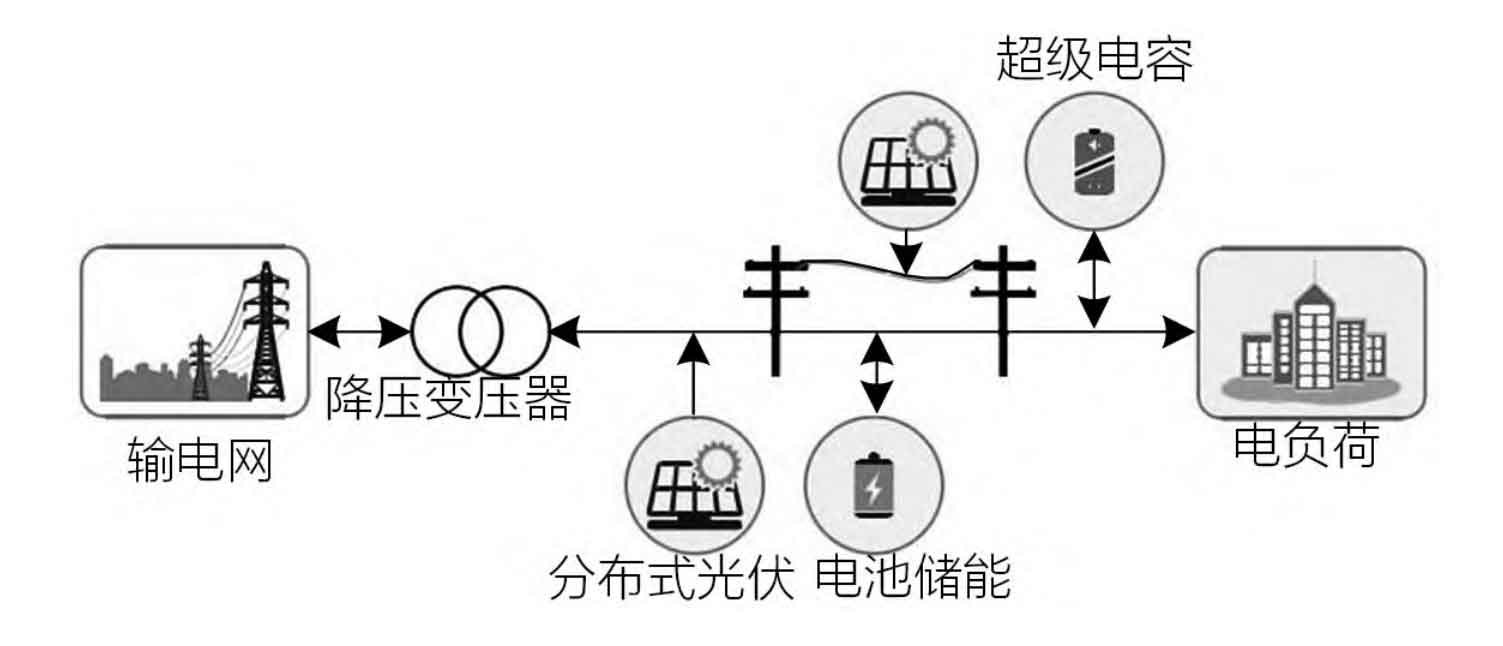
In order to effectively respond to fluctuations in distributed renewable energy output and improve system flexibility, a hybrid energy storage system can be composed of battery energy storage and supercapacitors, fully leveraging the complementary characteristics of the two in terms of energy density, power density, response time, etc., and carrying out multi time scale coordinated scheduling. Charging during peak and low load periods of photovoltaic output; Discharging during periods of low photovoltaic output and peak load can achieve spatiotemporal translation of electrical energy, promote the consumption of renewable energy, reduce voltage deviation caused by renewable energy uncertainty, and improve the reliability and economy of distribution network operation.
2. Distributed Robust Optimization Model Considering the Uncertainty of Renewable Energy
2.1 Photovoltaic Uncertainty and Wasserstein Uncertainty Set
Photovoltaic active output power has strong uncertainty, and there is usually a deviation between the predicted value of photovoltaic output and the true value. The true distribution of prediction errors can only be estimated with a limited sample set, and due to sample size and computational complexity, the true distribution of photovoltaic prediction errors is inconsistent with its empirical distribution. Therefore, it is necessary to adopt distributed robust optimization and address the above issues by constructing the Wasserstein uncertainty set. Wasserstein uncertainty set is a spherical uncertainty set based on Wasserstein probability distance. Compared to other types, it has strong limited sample guarantee and solvability, which can preserve as much prediction error information as possible while improving computational feasibility.
2.2 Two stage distributed robust optimization model
Distributed photovoltaic output has uncertainty, and the distribution network faces the risk of voltage exceeding limits, which seriously affects the safe and stable operation of the system. In order to balance system robustness and economy, researchers adopt distributed robust optimization to seek the optimal decision in the worst scenario, taking into account the probability distribution characteristics of photovoltaic output. At the same time, considering the complementary characteristics of hybrid energy storage systems on the scheduling time scale, a two-stage distributed robust optimization model (TSDRO) is adopted to achieve joint scheduling between day ahead and day ahead, improving system flexibility. The objective function of the two-stage distributed robust optimization model includes operating cost and risk cost, and the risk cost is related to random variables. The difficulty in solving this model is that the risk cost part includes the “minimum maximum” term, which cannot be directly solved. If the expected internal expression of risk cost is a piecewise linear function, then based on the constructed data driven Wasserstein uncertainty set, additional variables can be introduced to equivalently transform the risk cost part.
3. Voltage regulation strategy for active distribution systems with hybrid energy storage
3.1 Two-stage distributed robust voltage regulation framework for distribution systems
The two-stage distributed robust voltage regulation strategy flowchart of an active distribution system with hybrid energy storage is mainly used to solve the overvoltage problem caused by the high proportion of renewable energy integration in the active distribution system.
The hybrid energy storage system consists of battery energy storage and supercapacitor energy storage, which can fully leverage the complementary characteristics between the two. Utilizing battery energy storage to complete high-energy charging and discharging over a relatively long period of time can effectively suppress fluctuations in renewable energy output. At the same time, considering the characteristics of high power density and fast response speed of supercapacitors, but limited individual capacity, using them to respond quickly in a short period of time within a day can effectively address the problem of voltage exceeding limits caused by sudden and drastic fluctuations in renewable energy, and improve the reliability and economy of system operation. This article fully considers the strong correlation between different time scales and prediction granularity and prediction errors, and proposes a two-stage distributed robust optimization model for active distribution systems to ensure voltage safety. In the first stage, the Wasserstein spherical uncertainty set is constructed using the prediction error of the daily photovoltaic output, and a robust optimization model for the daily battery energy storage distribution with opportunity constraints is constructed to obtain the daily battery energy storage charging and discharging plan and photovoltaic pre scheduling plan. In the second stage, the battery energy storage scheduling results obtained in the first stage are used as constraints, and other equipment pre scheduling schemes are used as references. Model predictive control is used to continuously update the optimization period T, predict the photovoltaic output prediction error in the time domain, and establish a robust rolling optimization model for intraday distribution to obtain the actual scheduling results of supercapacitor energy storage, distributed photovoltaic, and main grid electricity trading.
3.2 Robust Optimization Model for Energy Storage Distribution of Day Ahead Batteries
In the first stage, a robust optimization model for battery energy storage distribution with opportunity constraints is constructed, and based on this, daily battery energy storage charging and discharging plans, photovoltaic active power reduction and reactive power output plans, and energy exchange plans for distribution and main networks are formulated. The core goal of optimizing scheduling in this stage is to control the node voltage within an acceptable range, promote the consumption of renewable energy, achieve optimal scheduling in the worst scenario, and improve the reliability and economy of system operation. To construct a Wasserstein spherical uncertainty set using the prediction error of solar output in the past, it is necessary to fully consider the uncertainty of renewable energy output and the resulting risk costs, and use Conditional Value at Risk (CVaR) to transform the opportunity constraint into a convex and solvable form. Due to the strong uncertainty and prediction error in the current photovoltaic output prediction, it is necessary to fully consider the risk of voltage exceeding the limit. In addition, considering the limited cycle life of battery energy storage, it is necessary to include the operating cost of battery energy storage in the objective function. To promote the consumption of renewable energy and reduce the occurrence of waste light, a penalty term for waste light should be added to the objective function. Photovoltaic inverters can provide adjustable reactive power within a certain range, and the cost of reactive power regulation should also be considered. At the same time, the distribution network can conduct electricity trading with the main network, selling electricity to the main network when there is excess photovoltaic output, and purchasing electricity from the main network when there is insufficient power supply to meet the load demand.
In the second stage, a robust model predictive control strategy for intraday supercapacitor distribution is proposed. Compared to the previous day, the daily photovoltaic prediction time scale is shorter, the prediction granularity is smaller, and the photovoltaic output prediction error is significantly reduced. However, considering that special situations such as cloud cover from the sun still occur, which can cause instantaneous and drastic changes in photovoltaic output. In addition, the daily scheduling plan will be implemented after a short time interval. Therefore, it is necessary to use model predictive control for rolling optimization to eliminate distributed photovoltaic output prediction bias, improve decision-making quality and solving efficiency. Supercapacitor energy storage has the advantages of fast response speed and long cycle life. In the second stage, it is used to suppress sudden short-term and severe fluctuations in photovoltaic output, ensuring the voltage safety of the active distribution system. The schematic diagram of model predictive control is shown in Figure 2.
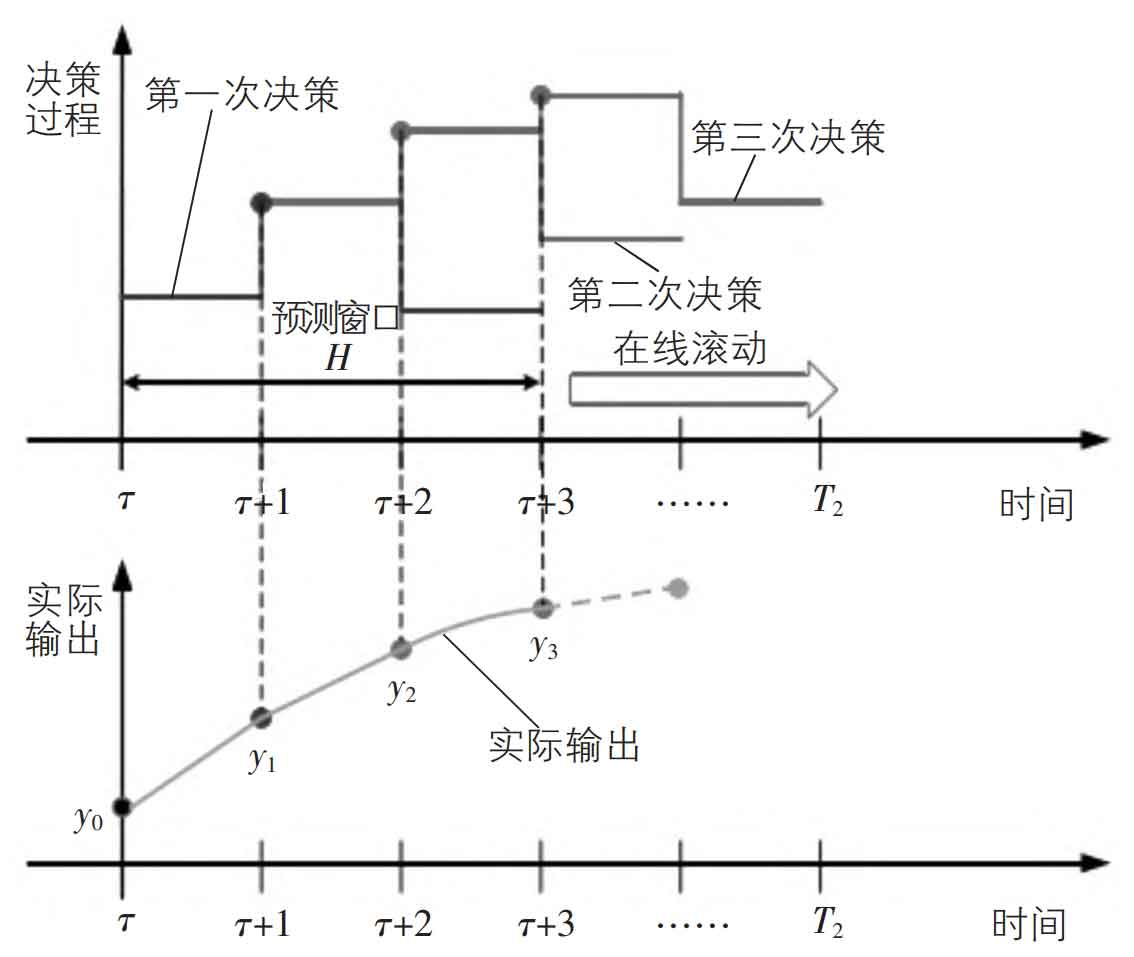
In the second stage, the super capacitor scheduling plan, photovoltaic reduction coefficient, and inverter reactive power output at time T are synergistically optimized within the window time domain to obtain the optimal decisions at multiple times within the current window time domain. Only by executing the scheduling results at the current time as the real output and moving the window time domain to the right for one time interval, can we rebuild the robust optimization model for supercapacitor distribution and update the uncertainty set of photovoltaic prediction errors. Then optimize the scheduling of the next window time domain, and so on, until the window time domain moves to the total scheduling period of 2T. The optimization scheduling results of multiple times within the window time domain can be directly output as the final result.
4. Case analysis
4.1 Basic information of the case
The effectiveness of the proposed two-stage distributed robust voltage regulation strategy for active distribution systems with hybrid energy storage is verified using a modified IEEE 37 node example. Considering the high proportion of renewable energy integration in the new power system, distributed photovoltaic power generation has been configured at 21 nodes in the active distribution system. The load demand and photovoltaic output are based on real data, and the curve is shown in Figure 3. The Wasserstein radii for daily and intraday photovoltaic output prediction errors are set to 0.1 and 0.01, respectively. The risk preference coefficient is selected as a typical value, with p=30.
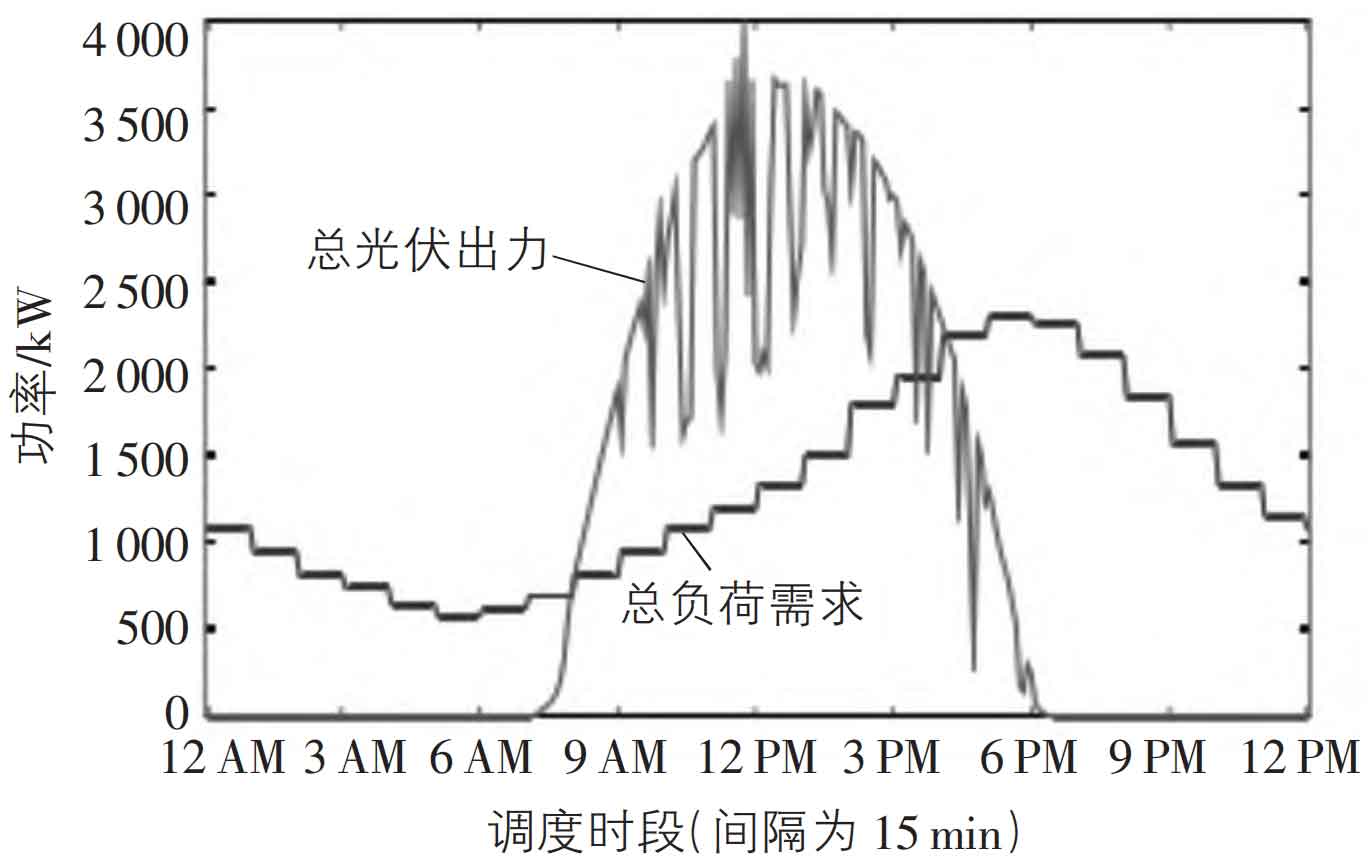
4.2 Optimization scheduling results before the day
(1) The battery energy storage action plan, the first stage battery energy storage charging and discharging power and storage energy scheduling results are shown in Figure 4 and Figure 5, respectively. From Figures 4 and 5, it can be seen that as the photovoltaic power generation increases, the battery energy storage begins to charge, and the charging power gradually increases until it reaches the maximum charging power. Then, it remains for a period of time to store the excess photovoltaic power generation. At around 6:00 pm, the photovoltaic output power gradually decreases to 0, and the battery energy storage begins to gradually discharge until the stored energy reaches 0. Battery energy storage is charged during peak photovoltaic output and discharged during low photovoltaic output and peak load, achieving spatiotemporal transfer of electrical energy.
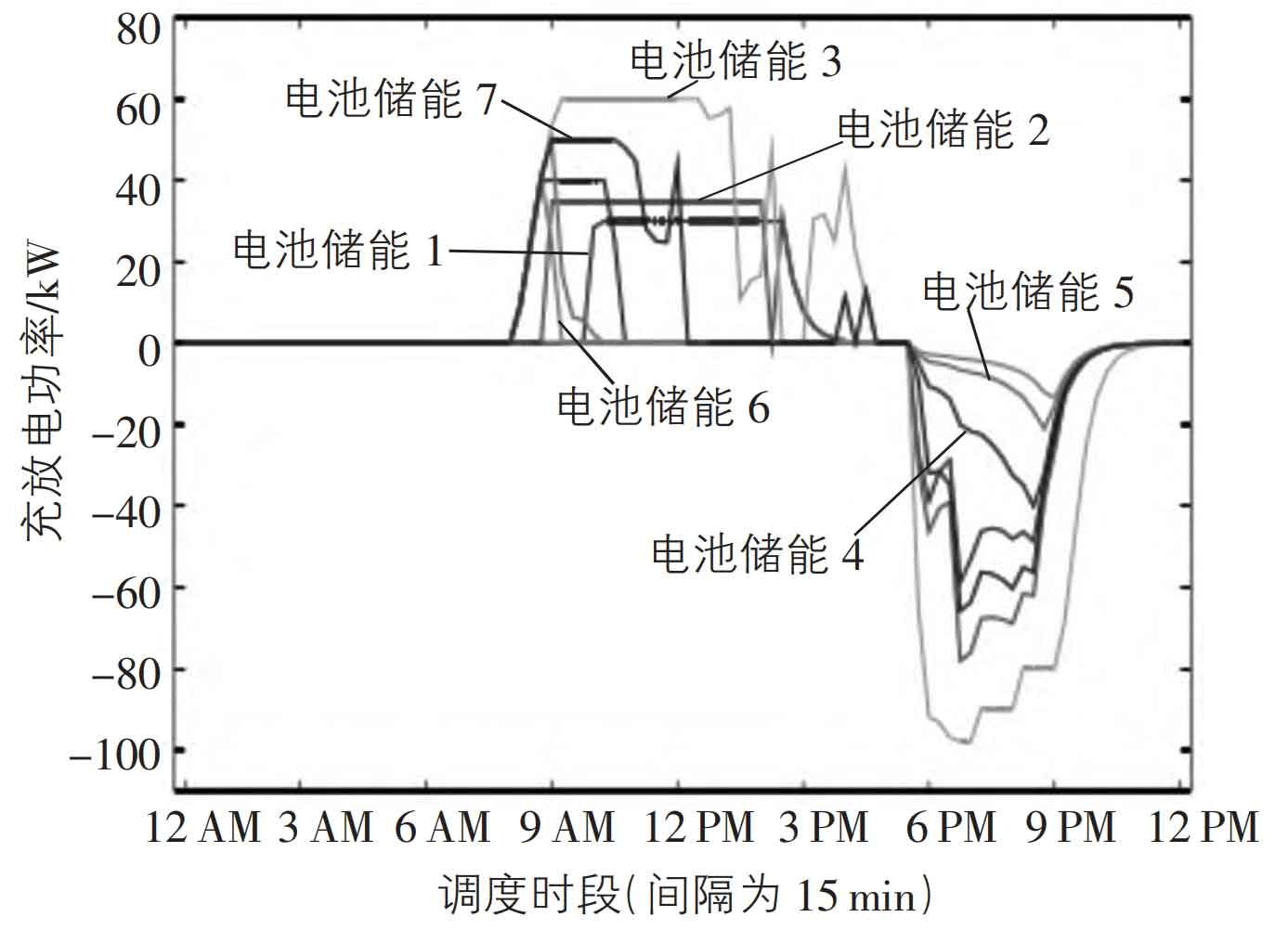
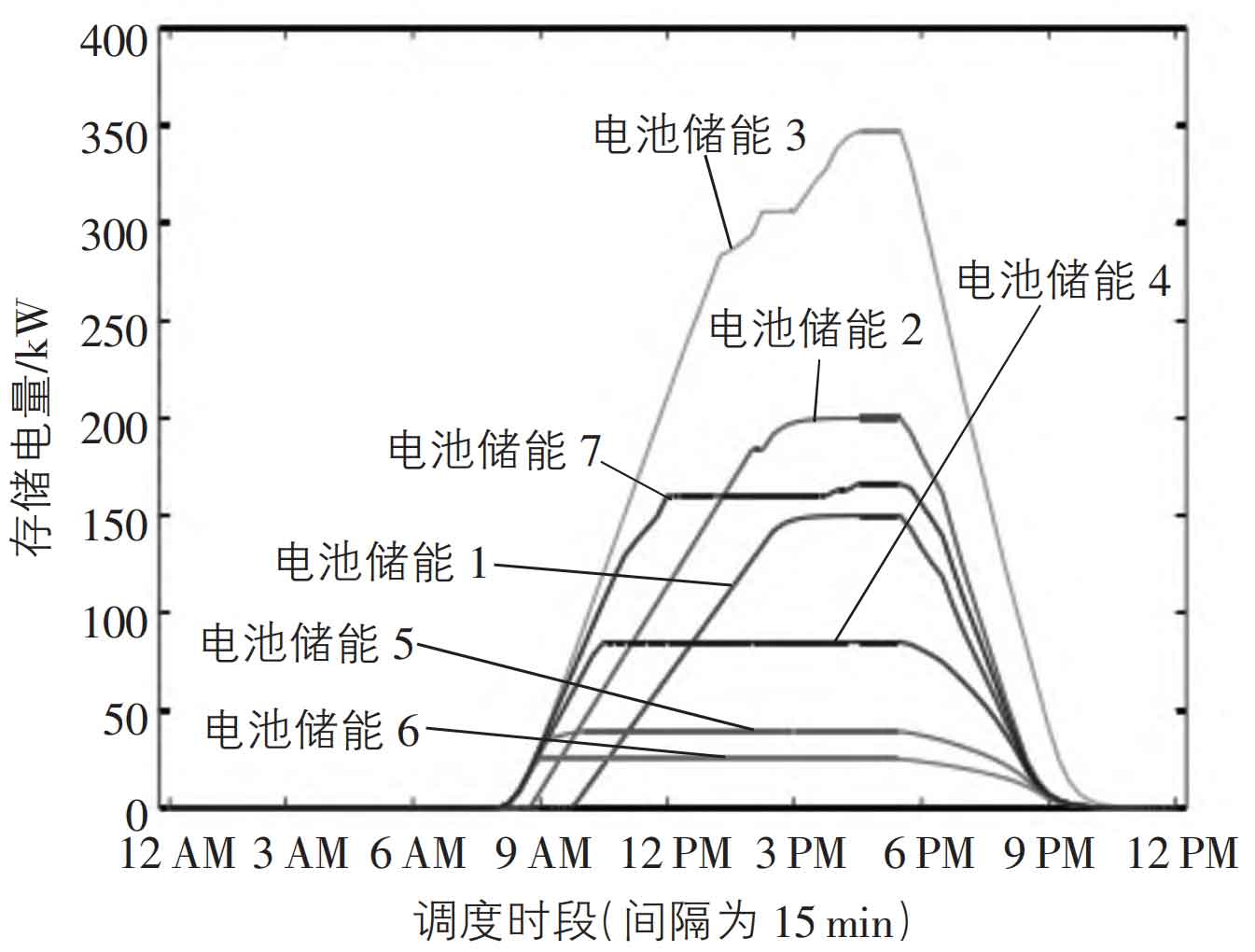
(2) The current voltage regulation results only include distributed photovoltaic power generation, and there is no initial node voltage fluctuation in the active distribution system with any energy storage regulation, as shown in Figure 6. As shown in Figure 6, with the increase of distributed photovoltaic output, the voltage of distribution network nodes will increase. During the period of excess photovoltaic output from 10:00 am to 3:00 pm, the node voltage continuously increases, and some nodes, especially the feeder terminals, experience overvoltage problems, with voltage fluctuations ranging from 0.978 to 1.07. After adding battery energy storage for the first stage of distributed robust voltage regulation, the node voltage changes are shown in Figure 7.
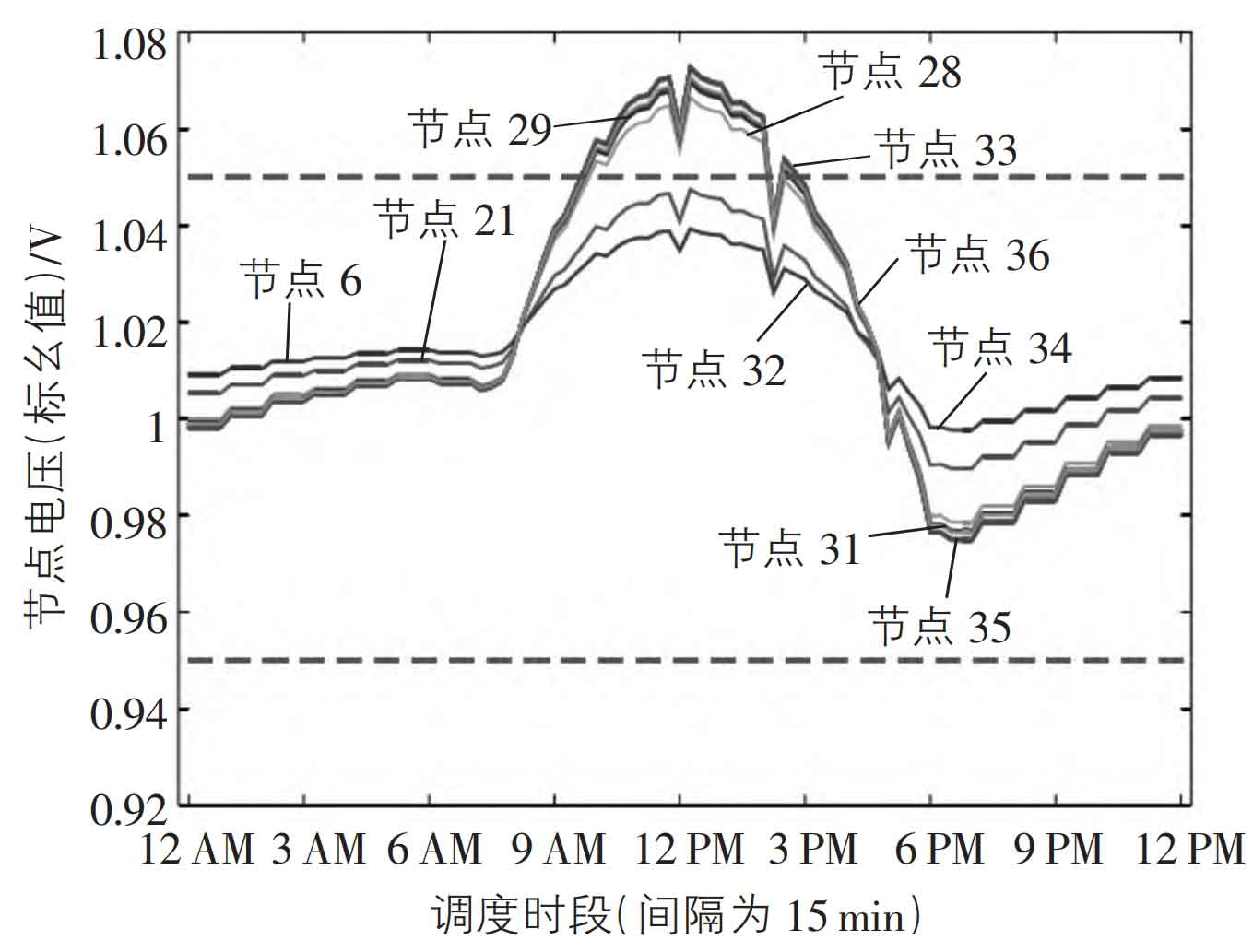
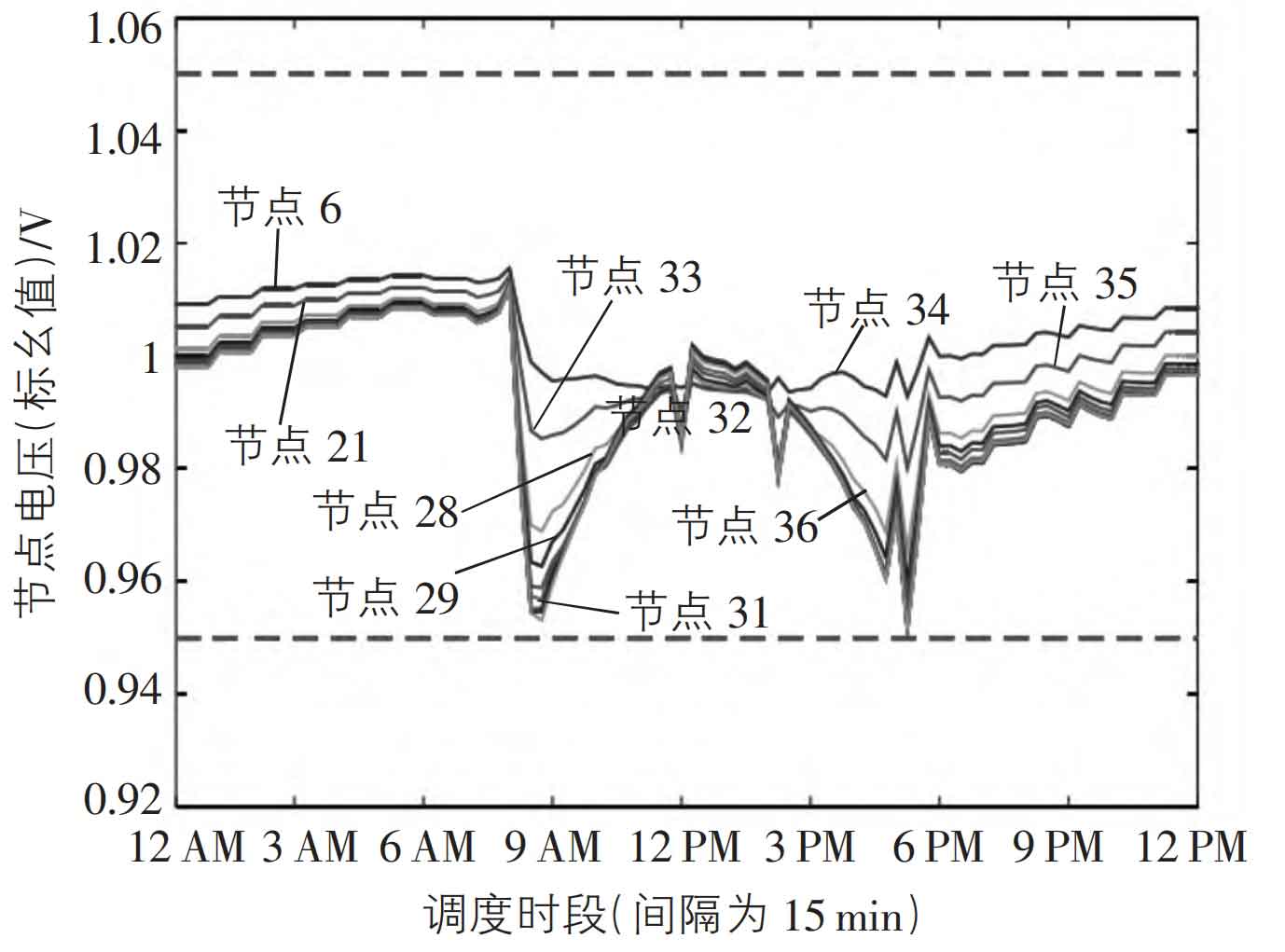
From Figure 7, it can be seen that the charging action of the battery energy storage starting at 9:00 am brought about a significant voltage drop, and the discharge actions starting at 6:00 pm respectively brought about a significant voltage rebound, effectively avoiding overvoltage problems during photovoltaic peak periods. The node voltage can be controlled within 0.95-1.02 V, effectively ensuring system voltage safety and improving the reliability and safety of system operation.
4.3 Optimization scheduling results within the day
4.3.1 Action plan for supercapacitors
Compared to battery energy storage, supercapacitors have a smaller capacity density and faster changes in charging and discharging power. When the photovoltaic output fluctuates rapidly, supercapacitors quickly respond, effectively suppressing the severe fluctuations caused by photovoltaic output. At the same time, it complements battery energy storage on a time scale, effectively suppressing voltage exceeding issues caused by the uncertainty of renewable energy output at different time scales, and ensuring the safe and stable operation of the power grid.
4.3.2 Distributed photovoltaic scheduling scheme
During the peak period of photovoltaic output, the inverter outputs inductive reactive power. As the photovoltaic output increases, the inductive reactive power emitted increases, reaching its peak around 12:00 noon and then decreasing. By 6:00 pm, the photovoltaic output is 0, and the inverter reactive power output also decreases to 0. At the same time, the magnitude of inverter reactive power compensation is related to the node position of photovoltaic installation. The farther the node position of photovoltaic installation is from the common coupling point, the longer the feeder line, the more significant the voltage rise phenomenon, and the greater the required reactive power compensation. Due to the large number and high penetration rate of distributed photovoltaics configured in the distribution network, as well as the limited reactive power regulation ability and configured energy storage capacity of photovoltaic inverters, photovoltaic output has to be reduced during peak periods. Compared to the situation without energy storage, the amount of abandoned light has significantly decreased, but there is still room for improvement in the proportion of photovoltaic absorption.
5.Conclusion
Two-stage distributed robust voltage regulation strategy for a comprehensive energy distribution system with multi energy storage was proposed, fully considering the uncertainty of renewable energy and thermal transmission dynamics. Recently, a MESS-DRO model considering thermal slow dynamics was constructed to formulate scheduling plans for battery energy storage and thermal energy storage. A SCESS-DROMPC model was also constructed to optimize multi time scale online rolling and adjust real-time bias, And output the results of supercapacitors, distributed photovoltaics, thermal coupling devices, electrical power exchange, and pneumatic power exchange. The calculation results show that the proposed two-stage voltage regulation strategy for a comprehensive energy distribution system with multi energy storage can fully leverage the complementary advantages of electric heating, solve the problem of voltage exceeding limits, improve the consumption level of renewable energy, and improve the economy of system operation.
